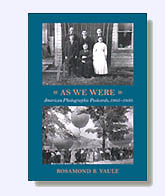“As We Were: American Photographic Postcards” Book Review
 |
Book Review by Greg French |
|
My brother, Bob, read this book before I did. He’s a Harvard graduate with a PhD and an extensive vocabulary, but he’s a populist at heart and in practice. He was animated and enthusiastic about the book. Nodding and gesturing he said: “She gets it.” AS WE WERE covers its subject, American Photographic Postcards, thoroughly and with insight, but the book does more than that. It transcends the genre and becomes a book about life: “We’re face to face with both their moment of reality in the card and their absolute transience.” The author’s scholarly approach is laced with wisdom and humanity. Who would think that a book about real photo postcards (to use the vernacular) would be so compelling? Ms. Vaule was introduced to photographic postcards as a child. Her grandfather had them in albums. “For my grandparents the card represented a souvenir of a place or a special occasion, a status proudly attained or an expression of delight in their son’s young life. For me, the card becomes a way of getting closer to them as they were before I entered into the continuum.” Real photo postcards were made by professional photographers and amateurs alike. The cards were “unpretentious, on home ground, cheap, and ready for mailing.” Surprisingly, the majority were not mailed but were used as souvenirs or gifts. Often these photographs depict people in their everyday clothes standing in front of the clapboards of their homes. The author elaborates on one example: “This is such a stable picture, all verticals and horizontals except for the collar and windswept skirt. Rebecca, her left foot solidly at center, is a pillar of cheerful strength.” Another card shows family in their Sunday best, out on a rural road, standing for their portrait; curiously, one young man sits apart from the group on a pile of stones. A delightful photograph of a boy on the ground with his hand on a resting pig carries the sender’s message on the back: “Dear Aunt….Joe wants to know if you know which one is he…..” Real photo postcards showed how people worked, and what they wore when they worked. There is an outdoor portrait of a group of postal workers, who hold their packages of mail like trophies. Their humble presentation becomes our treasure. In another scene, there’s humor in the two loggers who turn the saw blades on themselves. On another page, a huge barn with a symmetrical slope in front defines the four farmhands who stand in its doorway. An Ohio bootmaker looks like an actor on center stage.
The selection of photographs is especially rich. We see a group of children arm in arm, running in a joyous dance on the beach in Santa Barbara. We know it wasn’t as spontaneous as it appears, but who could’ve choreographed the two children to the right who are side by side with legs raised, or the bunching that occurred to the line at the left? Not all is blissful in this America. There is the photo of the general store with a message about the sick father on reverse. There’s the interior of Mary Fletcher Hospital where patients and nurses alike pose for the camera. The three performers from Hornbeak Tennessee seem to gawk at us, just as we gawk at them. We see George Schmitt’s Red Devil plane in flight, taken in rural Vermont. The plane transforms this card from mundane to captivating, and then we read the message: “This is Schmitt flying the day he was killed.” In looking through the imagery in this book, we have to abandon the concept that all is naive, for much of the work is informed, even if it’s informed by an earlier time. There are the Montpelier boys in front of the ruins of a still smoldering fire. Their dark clothes provide great contrast to the snow around them. A pedestrian is a blur and the dog is a ‘ghost’ image. This depiction of action is now perceived as a modern value, yet it’s as old as photography itself. We bring ourselves into these photographs. What’s more surreal than the Cincinnati flood scene showing an urban landscape populated only by people in boats with oars? This particular scene has added significance since Hurricane Katrina. One senses the hope and changing values of the time. A small town shows off its shiny fire engine. The store advertising “New & Second-Hand Furniture” reminds us that the recycling industry is not completely new. A young woman dives off a dock to this response: “I guess by the picture that the College girls have fully as good a time as we do.” We see people posed with machines and a couple of factory postcards could be right out of Charlie Chaplin’s Modern Times. Ms. Vaule’s sense of inclusion truly reflects the American experience. While celebrating diversity with pictures, the author points out the racist language on the reverse of an image of people in an alfalfa field as well as a disturbing sign above a group of Hopi and Navajo dancers. We marvel at the beauty of ‘Alaska woman’ and are intrigued by the woman holding a puppy by an empty chair. Don’t let the title AS WE WERE deceive you. It is accurate, but this is not a nostalgic book. It offers insight to who we are and how the past precedes the future. My brother is right. Rosamond Vaule does ‘get it.’ And while she ‘gets it’ her greater gift is in the telling.
Click the title for more information and discounted pricing through Amazon.com As We Were: American Photographic Postcards, 1905-1930
|
||||
Photograph: Collection of Rosamond Vaule, Copyright MMIV Rosamond Vaule. Used by Permission Text Copyright MMV Greg French American Museum of Photography and the logo are Service Marks of The American Photography Museum, Inc.
